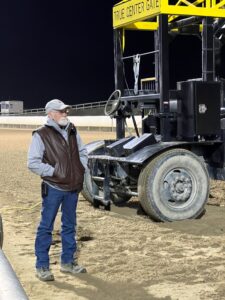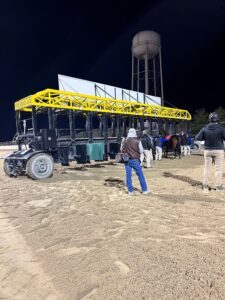Before, during, and after a race, the safety of the horses racing at any of the tracks in Pennsylvania is the top priority.
Prior to a horse entering Starting Gate, their health and soundness is evaluated to assure that they are fit to race. Evaluating the horses, and deeming them sound and fit to race is of the utmost importance, and those inspections are done initially by the State Horse Racing Commission.

Following the evaluation, the track veterinarian steps in for a further inspection, and at Hollywood at Penn National Race Course, Dr. Jerry Pack, DVM handles the responsibilities of that important position. With a career spanning 19 years practicing on the backside of numerous racetracks, Dr. Pack has been with Penn National for about 14 years.
“I am the Association Veterinarian at Penn National,” he explained. “I’m going to get a look at the horses after they’ve had their pre-race inspection of the morning, after they’ve been looked at in the paddock. I’m going to get the final look at them with a jockey on their back.”
Dr. Pack has a strong working relationship with the jockeys, and they have a great rapport. “They know that my rule is that, if they don’t like how a horse is going, whether I can see the horse is off or lame or not, I’m not going to allow that horse to run. So I’m depending on those jockeys a lot.”
Unfortunately, Dr. Pack may have to make the decision to not allow a horse to run. “Certainly, if I see a lame horse, whether they like it or not, I’m going to scratch him. But I depend on those jockeys because they’re going to feel more than I’m going to see.”
Dr. Pack continues to keep a watchful eye on the horses as they finish the race. “Depending on where I’m at, because I’m at the starting gate, so if we’re at the 3/4 chute, we’re running 3/4 of a mile, I’m able to watch those horses as they pull up, and see if there’s any issues with them. If I’m on the front side, if the gate is over at the mile-sixteenth, I will get a look at them pulling up when they unsaddle. Most of the time, depending on where it’s at, I really get a look at them. I will see them post-race, just depending on how good the area of sight is.”
Sadly, a horse, just like any other athlete, may suffer an injury. “When athletes compete, athletes get injured,” Dr. Pack explained. “The problem with our athletes (horses) is, with the size of them, an injury that can be repaired in a person is almost impossible to repair in a horse because of their size, and the complications that occur post-surgically. If you remember (2006 Kentucky Derby winner) Barbaro, they did everything they could do to repair the fractures, which went well, but then complications set in with the Laminitis and all. So, unfortunately in our athletes, it’s very difficult. I mean, you can repair them; you can repair some of them, some of them you cannot repair. The problem is, the complications post-surgically.”
“The problem with our athletes,” Dr. Pack emphasized, “I don’t care how many risk factors you look at, catastrophic injuries are unpredictable. These horses, they load those hooves at about 1000 lbs. per square inch, and all they have to do is step a little off-level to create a catastrophic injury.”
Citing the multitude of tracks that have seen a jump in their fatalities over the years, which included Santa Anita; Laurel Park; Churchill Downs; and others, Dr. Pack says that it is unfortunate that it cycles from track to track. “If you look at the Kentucky Derby, the Preakness Stakes, the Belmont Stakes, the Breeders’ Cup, there’s multiple veterinarians looking at these horses every day, and still we have catastrophic injuries. The numbers are certainly down with what has been instituted around the United States. Our numbers are definitely down. But every once in a while you get this rash that just makes everybody crazy.”
“As far as what’s going on with the industry right now, we know that HISA (Horseracing Integrity and Safety Authority) has taken over, and they have put in some regulations, which, at Penn National, we were already doing; really scrutinizing these horses prior to racing.”

Dr. Pack points out that, with the three types of track surfaces; synthetic; dirt; and turf; the synthetic is the safest surface as far as catastrophic injuries. “There are issues on the synthetic surface that a lot of people are not aware of, too. There are a lot of rear-end problems in horses that run on synthetic that you don’t see on dirt and turf. Not catastrophically, but something that is going to lay that horse up indefinitely. Turf is probably second safest, and then you go to dirt. And if you look at the numbers year-end, year-out, that’s how they will break down. And it may be that we run a whole lot more races on the dirt than the other surfaces.”
What it all comes down to for Dr. Pack to keep the athletes he so carefully watches over safe is, to evaluate them; keep a sharp eye on them; watch the track surface; and watch for soundness. “And listen to the jockeys!” he adds. “They can feel what they’re riding when I can’t see it.”











